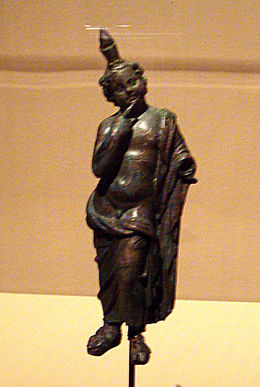Coat (ancient egypt)
The coat represents an ancient Egyptian insignia of the kings ( pharaohs ) and child deities.
Mythological connections
Origins

The coat has been documented since the early dynastic period . A precise definition of the mantle has not yet been made in Egyptology because the meaning has not been clarified. Originally the cloak served as a characteristic of the king and individual deities to hide the body or body parts.
Greco-Roman time
In contrast to its original use, the cloak has not been used to hide the child deities with the appendix "pa-chered" ( the child ) since the Ptolemaic period , but rather to frame the naked body parts, for example the hor-pa-chered .
Since child deities with the name extension “pa-chered” had a close mythological connection to the king, the associated coat can be an iconographic stylistic device that, among other things, identifies the wearer as a child's successor or later king. Osiris is shown wearing a similar garment in the temple of Philae , although the exact thematic reference remains unclear.
The mostly smooth blue coat fabric had a border at the hem with several parallel stripes that were decorated with multicolored (purple, green, red, blue) rectangles. In the pictorial program, the coat was almost always used for standing child deities.
An attachment is not visible. The hem of the coat usually begins at the elbow, continues over the front arm, which extends to the mouth, and then goes in an arc to the ankles.
literature
- Sandra Sandri: Har-pa-chered (Harpocrates). The genesis of an Egyptian child of gods (= Orientalia Lovaniensia analecta 151). Peeters, Leuven 2006, ISBN 90-429-1761-X , pp. 101-102.